(Press-News.org) UNIVERSITY PARK, Pa. — A widespread bacteria called Wolbachia and a virus that it carries can cause sterility in male insects by hijacking their sperm, preventing them from fertilizing eggs of females that do not have the same combination of bacteria and virus. A new study led by microbiome researchers at Penn State has uncovered how this microbial combination manipulates sperm, which could lead to refined techniques to control populations of agricultural pests and insects that carry diseases like Zika and dengue to humans.
The study is published in the March 8 issue of the journal Science.
“Wolbachia is the most widespread bacteria in animals and lives symbiotically within the reproductive tissues of about 50% of insect species, including some mosquitos and flies,” said Seth Bordenstein, professor of biology and entomology, director of the One Health Microbiome Center at Penn State, and one of the leaders of the research team. “Wolbachia has genes from a virus called prophage WO integrated into its genome. These genes — cifA and cifB — allow the bacteria to remarkably manipulate sperm and quickly spread through an insect population for their own good.”
When a male and female insect that both have Wolbachia mate, they successfully reproduce and pass on the bacteria. But when a male with Wolbachia mates with a female with no Wolbachia, the sperm are rendered lethal to the fertilized eggs, succumbing them to death. This system cunningly increases the proportion of offspring with Wolbachia and the virus in the next generation, because females with the bacteria successfully reproduce more frequently than females without.
This system is being used in several ongoing pilot studies across the world to control insect pests and the harmful viral diseases they carry. For example, to control a population of agricultural or human pests that do not have the bacteria, scientists release males with Wolbachia in order to crash the population.
“One of Wolbachia’s superpowers is that it blocks pathogenic RNA viruses such as Zika, dengue and chikungunya virus, so mosquitos with Wolbachia do not pass these viruses on to people when they bite,” Bordenstein said. “So, releases of both male and female mosquitos with Wolbachia in an area where it isn’t already present leads to replacement of the population with mosquitos that can no longer pass on a viral disease. The World Mosquito Program is now using Wolbachia to control viruses in 11 countries. With this study, we reveal the underlying mechanics of how this process works so we can fine-tune the technique to expand its scope in vector control measures.”
Wolbachia’s prophage WO genes code for proteins that interfere with normal development of sperm cells. These proteins impact a critical transformation during sperm development, when the sperm’s genome is repackaged and the sperm changes from a canoe-shape into a more refined needle-like shape.
“This shape change is incredibly important to the success of sperm, and any interference can impact the sperm’s ability to travel in the female reproductive tract and successfully fertilize the egg,” said Rupinder Kaur, assistant research professor of biology and entomology at Penn State and the other leader of the research team. “The transition is highly conserved in almost everything from insects to humans. Defects in this process can also cause male sterility in humans.”
According to the researchers, sperm is particularly prone to DNA damage and repair during this transition. In this study, they found that sperm exposed to Wolbachia, or the Cif proteins alone, had an elevated level of DNA damage at this stage. The DNA damage, if not repaired in a timely fashion, can result in abnormal sperm genome packaging, male infertility and embryonic inviability.
“These results confirmed the impact of Wolbachia and Cif proteins at this stage of sperm development, but we still wanted to know what was happening at earlier stages to trigger these changes,” Kaur said. “We conducted a series of tests to explore the structure and biochemical function of the Cif proteins and found that they can cleave messenger molecules called long non-coding RNA, which sets the stage to interfere with downstream development and function of the sperm.”
The researchers used fruit flies with Wolbachia to test the potential link between the bacteria and long non-coding RNA. They found that Wolbachia — or the Cif proteins alone — reduced the amount of these RNAs. Additionally, mutant flies with reduced expression of these RNAs in conjunction with Wolbachia had elevated levels of embryonic inviability because it augmented the defective transition process of sperm development. So, Kaur explained, the virus proteins control sperm by depleting the long non-coding RNAs required for a normal sperm function.
“Long non-coding RNAs do not make any proteins themselves, but they can have profound impacts on regulating the function of other genes required for sperm development,” Bordenstein said. “By altering this non-coding part of the genome, we found that Cif proteins start impacting sperm right from the earliest stages of development. Wolbachia’s prophage WO genes act like master puppeteers, manipulating sperm development in a way that allows their genes and the symbiotic bacteria to quickly spread through arthropod populations.”
Because the process of sperm development looks similar across the animal kingdom, the researchers said that knowledge of this process could lend insight into sterility challenges in humans as well as inform new control methods of harmful insect populations.
“Now that we have reverse engineered this process, we can fine tune methods of population control with Wolbachia that are already in use,” Kaur said. “We plan to take advantage of this knowledge to augment currently existing disease vector and pest control methods, and perhaps emulate the technique without Wolbachia or virus proteins in the long-term.”
In addition to Bordenstein and Kaur, the research team includes Angelina McGarry, research technologist II at Penn State; J. Dylan Shropshire, assistant professor at Lehigh University; and Brittany Leigh, a postdoctoral researcher at Vanderbilt University at the time of the research.
Funding from the National Institutes of Health, the U.S. National Science Foundation and Penn State supported this research.
END
How does a virus hijack insect sperm to control disease vectors and pests?
A new study reveals how viral proteins from symbiotic bacteria cause sterility in insects
2024-03-07
ELSE PRESS RELEASES FROM THIS DATE:
How the brain coordinates speaking and breathing
2024-03-07
CAMBRIDGE, MA -- MIT researchers have discovered a brain circuit that drives vocalization and ensures that you talk only when you breathe out, and stop talking when you breathe in.
The newly discovered circuit controls two actions that are required for vocalization: narrowing of the larynx and exhaling air from the lungs. The researchers also found that this vocalization circuit is under the command of a brainstem region that regulates the breathing rhythm, which ensures that breathing remains dominant over speech.
“When you need to breathe in, you have to stop vocalization. We found that the neurons that control vocalization ...
Shape-shifting ultrasound stickers detect post-surgical complications
2024-03-07
EVANSTON, Ill. — Researchers led by Northwestern University and Washington University School of Medicine in St. Louis have developed a new, first-of-its-kind sticker that enables clinicians to monitor the health of patients’ organs and deep tissues with a simple ultrasound device.
When attached to an organ, the soft, tiny sticker changes in shape in response to the body’s changing pH levels, which can serve as an early warning sign for post-surgery complications such as anastomotic leaks. Clinicians then ...
The Malaria parasite generates genetic diversity using an evolutionary ‘copy-paste’ tactic
2024-03-07
By dissecting the genetic diversity of the most deadly human malaria parasite – Plasmodium falciparum – researchers at EMBL’s European Bioinformatics Institute (EMBL-EBI) have identified a mechanism of ‘copy-paste’ genetics that increases the genetic diversity of the parasite at accelerated time scales. This helps solve a long-standing mystery regarding why the parasite displays hotspots of genetic diversity in an otherwise unremarkable genetic landscape.
Malaria is most commonly transmitted through the bites of female Anopheles mosquitoes infected with P. falciparum. The latest world malaria report ...
Loss of nature costs more than previously estimated
2024-03-07
Researchers propose that governments apply a new method for calculating the benefits that arise from conserving biodiversity and nature for future generations.
The method can be used by governments in cost-benefit analyses for public infrastructure projects, in which the loss of animal and plant species and ‘ecosystem services’ – such as filtering air or water, pollinating crops or the recreational value of a space – are converted into a current monetary value.
This process is designed to make biodiversity loss and the benefits of nature conservation more visible in political decision-making.
However, the international research team ...
Lack of functional eyes does not affect biological clock in zebrafish
2024-03-07
Functional eyes are not required for a working circadian clock in zebrafish, as a research team1 including CNRS scientists has now shown.
Though it is understood that the eye plays a key role in mammalian adaptation to day-night cycles, the circadian clock is most often studied in nocturnal vertebrates such as mice. The zebrafish, in contrast, is a diurnal vertebrate. Through observation of various zebrafish larvae lacking functional eyes,2 the team of scientists has demonstrated that the latter are not needed to establish circadian rhythms that remain synchronized with light-dark ...
The who's who of bacteria: A reliable way to define species and strains
2024-03-07
What’s in a name? A lot, actually.
For the scientific community, names and labels help organize the world’s organisms so they can be identified, studied, and regulated. But for bacteria, there has never been a reliable method to cohesively organize them into species and strains. It’s a problem, because bacteria are one of the most prevalent life forms, making up roughly 75% of all living species on Earth.
An international research team sought to overcome this challenge, which has long plagued scientists who study bacteria. Kostas Konstantinidis, Richard ...
Forbes ranks the University of Colorado Denver | Anschutz Medical campus among America’s best employers
2024-03-07
The University of Colorado Denver | Anschutz Medical Campus is listed as one of Forbes America’s Best Large Employers for 2024.
The 2024 list of “America’s Best Employers” was conducted by Forbes and market research firm Statista, the world-leading statistics portal and industry ranking provider.
“This ranking is meaningful to our organization because the people who work at CU Anschutz drive our success as a leading academic medical campus by providing unparalleled patient care services, being a premier national leader in research and innovation, and fostering a supportive learning ...
NJIT professor trains college counselors to help fight antisemitism
2024-03-07
As data from the Anti-Defamation League shows antisemitism growing on college campuses in recent years and spiking after the Hamas-Israel conflict, a New Jersey Institute of Technology researcher is doing her part to combat the trend by developing a training model that will help prepare mental health professionals who work with Jewish students.
Modern students are hearing people chant slogans without understanding the intentions behind the words, or finding swastikas and other anti-Jewish graffiti on their campuses, but they are not encountering suitably trained counselors and psychologists who understand their ...
For new moms who rent, housing hardship and mental health are linked
2024-03-07
Becoming a parent comes with lots of bills. For new mothers, being able to afford the rent may help stave off postpartum depression.
“Housing unaffordability has serious implications for mental health,” said Katherine Marcal, an assistant professor at the Rutgers School of Social Work and author of a study published in the journal Psychiatry Research. “For mothers who rent their homes, the ability to make monthly payments appears to have a correlation to well-being.”
Housing hardship – missing rent or mortgage payments, moving in with others, being evicted ...
MD Anderson research highlights for March 7, 2024
2024-03-07
HOUSTON ― The University of Texas MD Anderson Cancer Center’s Research Highlights showcases the latest breakthroughs in cancer care, research and prevention. These advances are made possible through seamless collaboration between MD Anderson’s world-leading clinicians and scientists, bringing discoveries from the lab to the clinic and back.
Recent developments at MD Anderson offer clinical insights into a novel treatment strategy for patients with relapsed/refractory acute myeloid leukemia (AML), molecular insights into Burkitt lymphoma development, a therapeutic target to overcome ...
LAST 30 PRESS RELEASES:
Heart-brain connection: international study reveals the role of the vagus nerve in keeping the heart young
Researchers identify Rb1 as a predictive biomarker for a new therapeutic strategy in some breast cancers
Survey reveals ethical gaps slowing AI adoption in pediatric surgery
Stimulant ADHD medications work differently than thought
AI overestimates how smart people are, according to HSE economists
HSE researchers create genome-wide map of quadruplexes
Scientists boost cell "powerhouses" to burn more calories
Automatic label checking: The missing step in making reliable medical AI
Low daily alcohol intake linked to 50% heightened mouth cancer risk in India
American Meteorological Society announces Rick Spinrad as 2026 President-Elect
Biomass-based carbon capture spotlighted in newly released global climate webinar recording
Illuminating invisible nano pollutants: advanced bioimaging tracks the full journey of emerging nanoscale contaminants in living systems
How does age affect recovery from spinal cord injury?
Novel AI tool offers prognosis for patients with head and neck cancer
Fathers’ microplastic exposure tied to their children’s metabolic problems
Research validates laboratory model for studying high-grade serous ovarian cancer
SIR 2026 delivers transformative breakthroughs in minimally invasive medicine to improve patient care
Stem Cell Reports most downloaded papers of 2025 highlight the breadth and impact of stem cell research
Oxford-led study estimates NHS spends around 3% of its primary and secondary care budget on the health impacts of heat and cold in England
A researcher’s long quest leads to a smart composite breakthrough
Urban wild bees act as “microbial sensors” of city health.
New study finds where you live affects recovery after a hip fracture
Forecasting the impact of fully automated vehicle adoption on US road traffic injuries
Alcohol-related hospitalizations from 2016 to 2022
Semaglutide and hospitalizations in patients with obesity and established cardiovascular disease
Researchers ‘listen in’ to embryo-mother interactions during implantation using a culture system replicating the womb lining
How changing your diet could help save the world
How to make AI truly scalable and reliable for real-time traffic assignment?
Beyond fragmented markets: A new framework for efficient and stable ride-pooling
Can shape priors make road perception more reliable for autonomous driving?
[Press-News.org] How does a virus hijack insect sperm to control disease vectors and pests?A new study reveals how viral proteins from symbiotic bacteria cause sterility in insects







